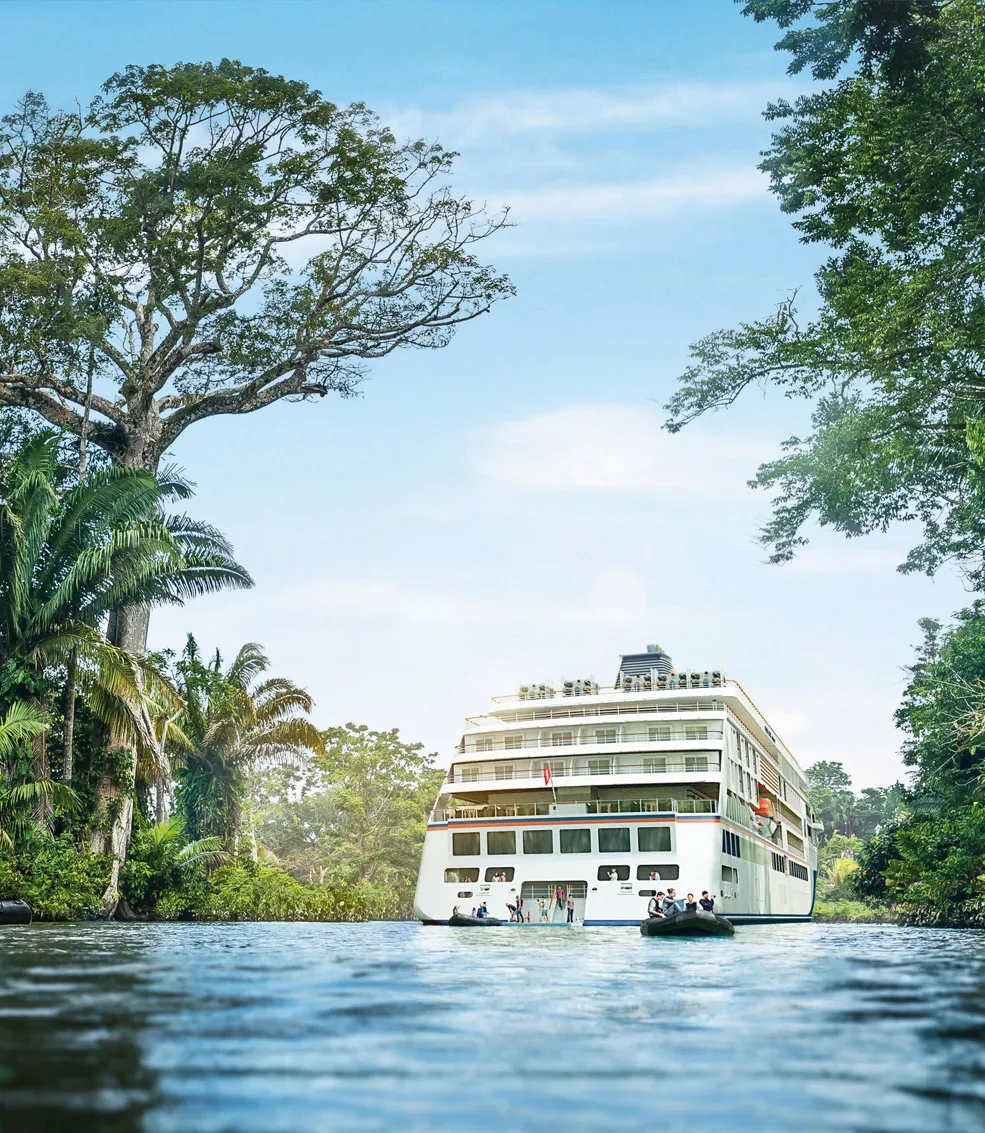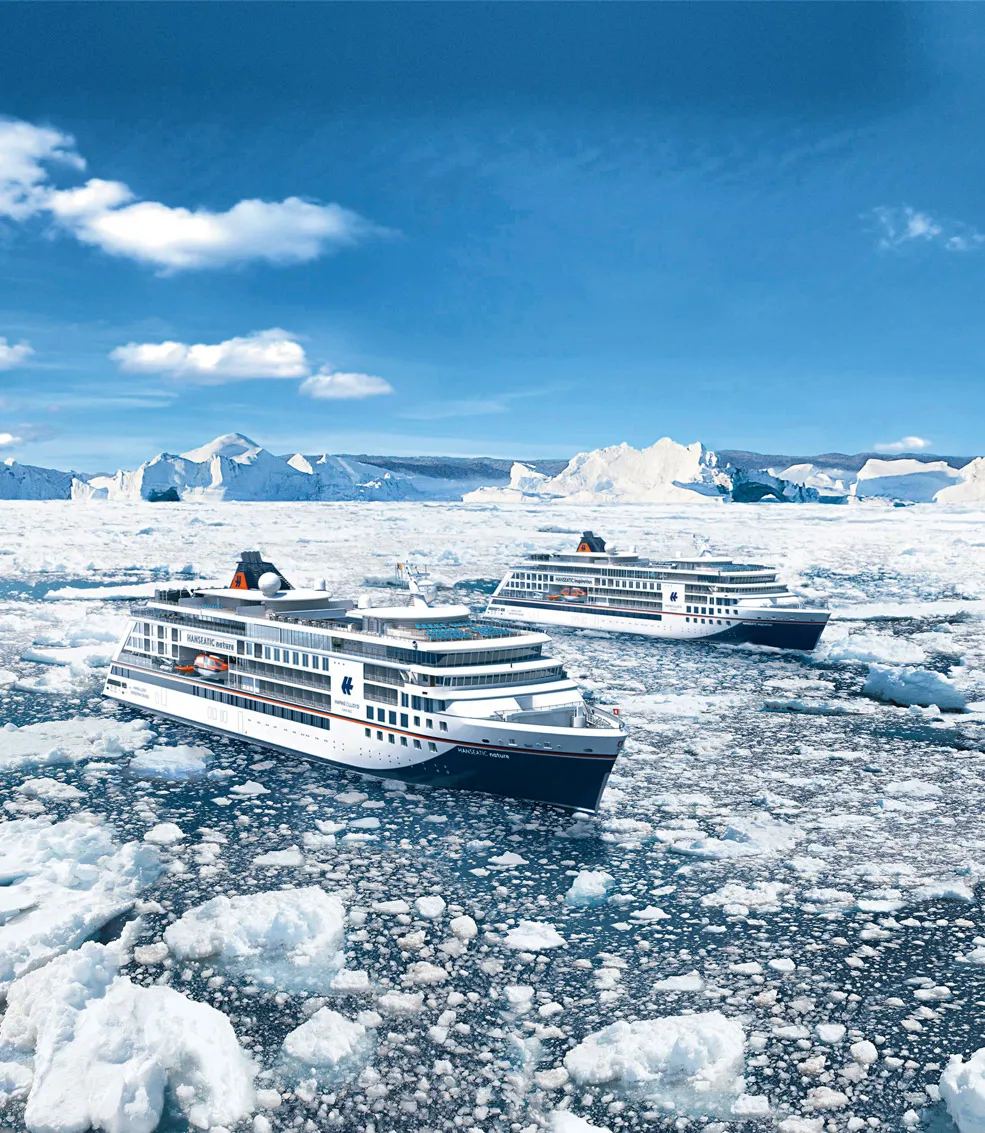Ready to face the extremes
Whether Arctic, Antarctic or Amazon, today’s expedition cruise ships take their passengers to the most remote natural wonders. Hapag-Lloyd Cruises is one of the sector’s major players. Head of New Builds Henning Brauer speaks about challenges to overcome when constructing these vessels, and the plans for the future.
On a grey Friday afternoon, Dr Henning Brauer is sitting in his office in Hamburg’s iconic Berliner Bogen office complex. The rain is relentlessly hammering the windows. The Arctic and its natural wonders is far away. Yet it is here, on the desk of the Head of New Builds, that the plans for the next-generation ships of Hapag-Lloyd Cruises are slowly taking shape – in drawings, software applications and in Brauer’s head.
The shipbuilding engineer joined the company eight years ago, initially working with the Europa 2 project team. Today he heads a team of five, overseeing the complex design process for Hapag- Lloyd Cruises’ two future expedition cruise ships HANSEATIC nature and HANSEATIC inspiration. “This contract is a real challenge,” says Brauer, his eyes shining with excitement. “These vessels not only have to be comfortable, economical and efficient; they must satisfy the most stringent environmental requirements as well,” the 39-year-old shipbuilder points out. Their destinations will be the highly regulated Arctic, Antarctic and Amazon regions. “It is the desire to experience nature that makes customers book with us,” says Brauer. Expedition cruises have never been more popular among passengers: “All the numbers tell us that these vessels will be very well occupied. We are already receiving some enquiries for these newbuilds,” reports Karl J. Pojer, President and CEO of Hapag-Lloyd Cruises.

Expedition pioneers
But future passengers must still be patient and wait until the two vessels will finally launch. The expedition ships are under construction at Vard shipyard. Earlier this year the keels were laid down and steel cutting began; HANSEATIC nature is scheduled to be christened and take her maiden voyage in April 2019. HANSEATIC inspiration is to follow her six months later.
What is unusual about this project: Vard have been experts in building offshore and fishing vessels but the Hapag-Lloyd Cruises contract is the yard’s first engagement in the cruise ship segment. This situation is not unlike the order placed by Hurtigruten with Kleven Verft: The Scandinavian cruise ship owner is having as many as four new expedition ships built at the yard which has so far been focused on supply and other specialized vessels.
“A small ship is no less complex than a big one. However, an expedition vessel is clearly more demanding than a conventional cruise ship,” Brauer points out. “Vard have been able to convince us of their high quality standards.” The Norwegian yard had plenty of experience building smaller vessels as well as iceclass ships, he adds.

Close cooperation
Apart from making the best of the limited space available on board, implementing the new Polar Code is probably the most challenging aspect in designing the vessels. “The tightened regulations ensure a higher level of safety – while at the same time making the ship roughly 200 tonnes heavier, costing plenty of precious space and raising the costs. All these are factors we have to compensate for by enhancing efficiency in other places,” Brauer explains. Hapag-Lloyd Cruises and Vard are handling this together. “We are honoured to have been chosen by Hapag-Lloyd Cruises for this project,” says Roy Reite, President and CEO of Vard. “A leading player like Hapag-Lloyd Cruises placing their trust in Vard’s capabilities to develop these unique, high-end vessels shows the recognition we have quickly earned in this segment of the speciality shipbuilding market.”
DNV GL is providing specific assistance to the owner and the yard: “For example, our Maritime Advisory services help owners quickly determine the Polar Code’s requirements relevant to their vessels, assess how close they are to compliance, and develop an action plan,“ says Steven Sawhill, Discipline Leader, Cold Climate Advisory Services at DNV GL – Maritime.
Since increased fuel consumption will play a key role for the new ships, which will be built to a higher ice class, DNV GL has optimized the interplay between the hull form, the initial general arrangement and the stability requirements. This will lead to a reduced fuel bill of up to ten per cent.
The experts of DNV GL, Vard and Hapag-Lloyd Cruises had investigated more than 100,000 different hull shapes during the development stage. “We were very pleased to have been able to exceed Hapag-Lloyd Cruises’ expectations and offer an optimization solution that demonstrates that efficiency and sustainability go hand in hand,” says Knut Ørbeck-Nilssen, CEO DNV GL – Maritime.

Sensitive sea regions
The glass walls of Brauer’s first-floor office are covered with engineering drawings: cross sections, detail representations, deck floor plans. “The challenge in shipbuilding is in the details,“ says Brauer, looking at the drawings. “From wiring and colours through to every individual piece of steel, everything must be perfectly matched.“ Which makes the designer‘s work incredibly complex. Not to forget the tight environmental regulations. “We will be navigating in sensitive sea regions. No wonder the demands are extreme,“ the ship expert adds. To meet the new regulatory requirements, the ships must be built 15 to 20 per cent larger per passenger than 30 years ago, Brauer estimates. Not only are they more complex to design and build; their operational systems are much more sophisticated as well: a selective catalytic reduction system filters out 95 per cent of noxious emissions; a Promas rudder with a custom-designed propeller cuts fuel consumption; and state-of-the-art “E-Zodiacs” feature electric propulsion. And when it comes to waste disposal and wastewater-treatment, the owner naturally favours sustainable technologies as well.
“In building these ships we make sure we are always on the safe side by going beyond what the regulations require,” Brauer says. After all, the longest trip without shore excursions is 32 days. “If anything goes wrong, we will be on our own. There will be nothing but ice for thousands of miles.“
The regions beyond the 60th parallel are definitely considered to require the highest navigational skills. But with highly qualified crews, advanced technology and smart ship design, Hapag-Lloyd Cruises can count itself among the top players. “We have been active in this segment since the early 1990s and are in fact one of its pioneers. Our extensive experience is a clear competitive advantage,” says Brauer. Reason enough for the industry to watch the development carefully.
With its advanced newbuilds HANSEATIC nature and HANSEATIC inspiration, Hapag-Lloyd Cruises is once again raising the bar, combining its expertise from two segments: expedition and luxury cruises.
